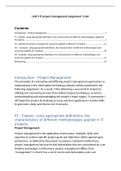Unit 9 IT project management assignment 1 LAA
Contents
Introduction - Project Management......................................................................................................1
P1 - Explain, using appropriate definitions, the characteristics of different methodologies applied in
IT projects..............................................................................................................................................1
P2 - Explain the project management structures applied in different IT projects................................21
M1 - Compare, using appropriate definitions, the characteristics of different methodologies and
structures applied in IT projects..........................................................................................................30
D1 - Evaluate, using appropriate definitions, the characteristics of different methodologies and
structures applied in IT projects..........................................................................................................41
Referencing..........................................................................................................................................43
Introduction - Project Management
The principles of contrasting and differing project management approaches as
implemented in the information technology industry will be examined in the
following assignment. As a result, I'll be delivering a successful IT project by
utilising and uncovering at least three distinct project techniques, as well as
comprehending and acknowledging the project's major stages. To summarise, I
will begin the project by studying an issue and then applying my creative skills
to generate a large and diverse set of answers.
P1 - Explain, using appropriate definitions, the
characteristics of different methodologies applied in IT
projects.
Project Management:
Project management is the application of processes, methods, skills, and
expertise to achieve specific project goals and objectives within agreed-upon
parameters, as defined by the project acceptance standard. Furthermore,
project management has end-to-end deliverables that are constrained by a set
timeline and budget. Furthermore, project management differs from
"management" in that it has a set of end-to-end deliverables and a set
,timeframe, as opposed to management, which is a continuous process. As a
result, a project manager would require a diverse set of talents, including
frequently technical skills, obviously people management skills, and adequate
business understanding.
What is a project?
A project is a unique, temporary undertaking undertaken to achieve and
accomplish predetermined aims or objectives, which can be defined in terms
of outputs, outcomes, or benefits. Furthermore, a project is often seen as a
success if it achieves the goals or objectives based on their acceptability, within
the agreed-upon timeframe and budget. Every project also has elements and
components such as time, cost, and quality.
Time - planning refers to a set of techniques for creating, growing, and
presenting plans that show when work will be done.
Cost - how are the necessary financial resources acquired and trade
controlled?
Quality - how will the deliverables' and management processes' suitability for
purpose be ensured
Defining why a project is needed; overseeing the project's risks, challenges,
and modifications; and overseeing the project budget
Management of service providers
Managing and motivating the project delivery team
Obtaining business approval and finance
,Putting together a business case to justify the investment
Creating and implementing a project management strategy
capturing project requirements, specifying the quality of outputs, taking into
account resources and timeframes
Observing progress that isn't going according to plan
Maintaining contact with stakeholders and the project team
When it is appropriate, shutting down the project in a measured manner.
Are the primary components of a project management plan
Scope Statement
Critical Success Factors
Deliverables
Work Breakdown Structure
Schedule
Budget
Quality
Human Resources Plan
Stakeholder List
Communication
Risk Register
Procurement Plan
Source: Project Management Plan – The 12 Core Components (projectengineer.net)
What is the purpose of Project Management?
, Furthermore, project management aims to provide a final product that will
differentiate the company that launched the project. Aside from that, it is the
start-up, planning, and administration of a number of tasks that are required to
deliver this ultimate product.
When should Project Management be used?
Projects are separate from routine business activities and occur when a
company wants to deliver a solution to a set of demands and requirements
within a certain budget and timeline. Furthermore, Projects necessitate the
assembling of a team of individuals for the time being in order to focus their
attention on certain project goals and objectives. As a result, successful
teamwork is critical to project success.
In Project Planning, there are six distinct methods to follow:
Stakeholders should be identified and met with.
Furthermore, everybody who may be impacted by the outcomes of your
project plan, including clients and end-users, is included as a Stakeholder.
Furthermore, when creating your project strategy, make sure to identify all
stakeholders and consider their concerns. Initiate a scope baseline, budget,
and timeline with the project sponsors and key stakeholders to communicate
their needs and expectations for the project.
Goals must be established and prioritised -




